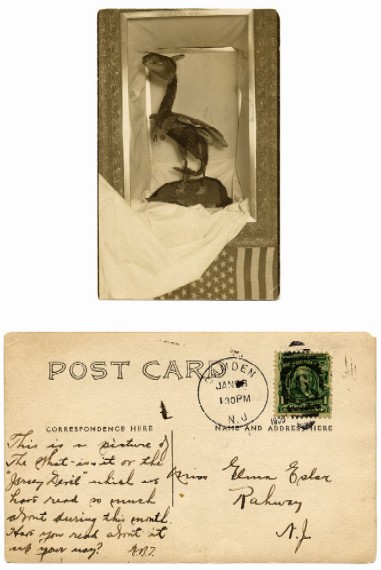
April 10, 2006
Come on in! See the Jersey Devil. Step right up. Get your tickets here. Look inside and see the actual Jersey Devil. Actually visible below, for real…

In circus, sideshow, and carnival jargon, the gaff is the gimmicked item, the taxidermy fake, the rigged prop often used by the illusionists, the sideshow artists, the showmen to turn the tip, that is, get the audience, to enter the sideshow, tent, attraction, freakshow, exhibition.
The Jersey Devil and the gaff go hand-in-hand. Take what happened…a hundred years ago.
In 1906 huckster Norman Jefferies, publicity manager for C.A. Brandenburgh’s Arch Street Museum in Philadelphia, came upon an old book which mentioned Mrs. Leeds’ curious offspring [the tale of the Jersey Devil and its birth], and it gave him an idea.
With attendance at his shows declining, Jefferies had been on the lookout for a stunt to bring the crowds back. Unfortunately for him, the Philadelphia papers, having been taken in by earlier Jefferies tricks, were not about to offer him any cooperation. So he planted this story in a South Jersey small-town weekly:
The “Jersey Devil,” which has not been seen in these parts for nearly a hundred years, has again put in its appearance. Mrs. J. H. Hopkins, wife of a worthy farmer of our county, distinctly saw the creature near the barn on Saturday last and afterwards examined its tracks in the snow.
The report created a sensation. All over the state men and women started glancing over their shoulders and bolting doors and windows. While always taking care publicly to profess skepticism, Jerseyites steadfastly refused to take any chances.
What if the monster was real after all? Had not an “expert” from the Smithsonian Institution said that it “bore out his long cherished theory that there still existed in hidden caverns and caves, deep in the interior of the earth, survivors of those prehistoric animals and fossilized remains…”? The expert was sure the Devil was a pterodactyl.
Shortly thereafter the animal was captured by a group of farmers. After making sure every paper around got the news, Jefferies took the “Devil” with him to Philadelphia and placed it on exhibition in the Arch Street Museum. The crowds, huge and mostly uncritical, gazed in wonder at the thing—actually a kangaroo with bronze wings fastened to its back and green stripes painted the length of its body.

Jefferies confessed in 1929 that he had bought the animal from a dealer in Buffalo, N.Y. and let it loose in a wooded area of South Jersey where it was certain to be caught without difficulty.
The Woodbury Daily Times got into the act, too, reporting in its December 15, 1925, issue that farmer “William Hyman” had killed an unknown animal after it raided his chicken coop. “Hyman describes the beast,” the paper said, “as being as big as a grown Airedale with black fur resembling Astrakhan; having a kangaroo fashioned hop; forequarters higher than its rear, which were always crouched; and hind feet of four webbed toes.”

Fine, except that “William Hyman” never existed. And neither, needless to say, did his [real, authentic, actual] specimen of the Jersey Devil.
Extracted from Mysterious America, copyright 1983, 2001, 2006, Loren Coleman.
For another item on the Jersey Devil, click here.
About Loren Coleman
Loren Coleman is one of the world’s leading cryptozoologists, some say “the” leading living cryptozoologist. Certainly, he is acknowledged as the current living American researcher and writer who has most popularized cryptozoology in the late 20th and early 21st centuries.
Starting his fieldwork and investigations in 1960, after traveling and trekking extensively in pursuit of cryptozoological mysteries, Coleman began writing to share his experiences in 1969. An honorary member of Ivan T. Sanderson’s Society for the Investigation of the Unexplained in the 1970s, Coleman has been bestowed with similar honorary memberships of the North Idaho College Cryptozoology Club in 1983, and in subsequent years, that of the British Columbia Scientific Cryptozoology Club, CryptoSafari International, and other international organizations. He was also a Life Member and Benefactor of the International Society of Cryptozoology (now-defunct).
Loren Coleman’s daily blog, as a member of the Cryptomundo Team, served as an ongoing avenue of communication for the ever-growing body of cryptozoo news from 2005 through 2013. He returned as an infrequent contributor beginning Halloween week of 2015.
Coleman is the founder in 2003, and current director of the International Cryptozoology Museum in Portland, Maine.
Filed under Artifacts, Breaking News, Cryptotourism, CryptoZoo News, Cryptozoology, Museums, Pop Culture, Public Forum, Swamp Monsters